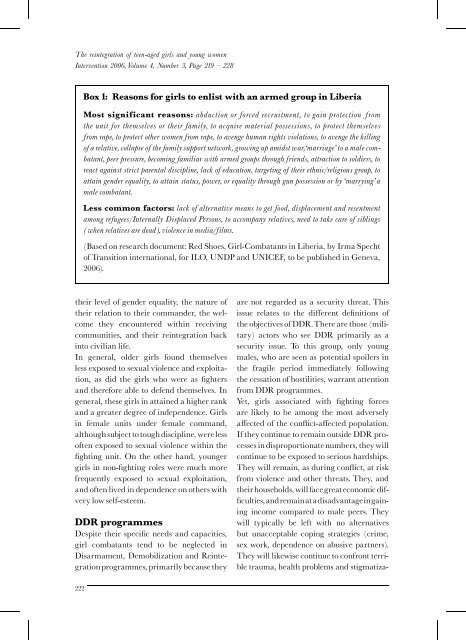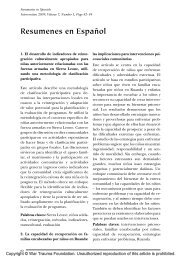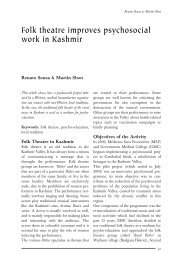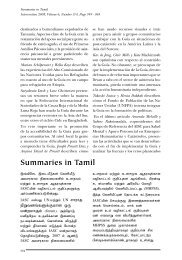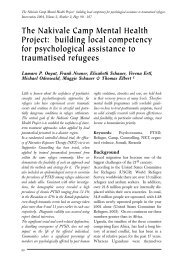The reintegration of teenage girls and young women
The reintegration of teenage girls and young women
The reintegration of teenage girls and young women
Create successful ePaper yourself
Turn your PDF publications into a flip-book with our unique Google optimized e-Paper software.
<strong>The</strong> <strong>reintegration</strong> <strong>of</strong> teen-aged <strong>girls</strong> <strong>and</strong> <strong>young</strong> <strong>women</strong><br />
Intervention 2006, Volume 4, Number 3, Page 219 ^ 228<br />
Box 1: Reasons for <strong>girls</strong> to enlist with an armed group in Liberia<br />
Most significant reasons: abduction or forced recruitment, to gain protection from<br />
the unit for themselves or their family, to acquire material possessions, to protect themselves<br />
from rape, to protect other <strong>women</strong> from rape, to avenge human rights violations, to avenge the killing<br />
<strong>of</strong> a relative, collapse <strong>of</strong> the family support network, growing up amidst war,‘marriage’to a male combatant,<br />
peer pressure, becoming familiar with armed groups through friends, attraction to soldiers, to<br />
react against strict parental discipline, lack <strong>of</strong> education, targeting <strong>of</strong> their ethnic/religious group, to<br />
attain gender equality, to attain status, power, or equality through gun possession or by ‘marrying’a<br />
male combatant.<br />
Less common factors: lack <strong>of</strong> alternative means to get food, displacement <strong>and</strong> resentment<br />
among refugees/Internally Displaced Persons, to accompany relatives, need to take care <strong>of</strong> siblings<br />
(when relatives are dead), violence in media/films.<br />
(Based on research document: Red Shoes, Girl-Combatants in Liberia, by Irma Specht<br />
<strong>of</strong>Transition international, for ILO, UNDP <strong>and</strong> UNICEF, to be published in Geneva,<br />
2006).<br />
their level <strong>of</strong>gender equality, the nature <strong>of</strong><br />
their relation to their comm<strong>and</strong>er, the welcome<br />
they encountered within receiving<br />
communities, <strong>and</strong> their <strong>reintegration</strong> back<br />
into civilian life.<br />
In general, older <strong>girls</strong> found themselves<br />
less exposed to sexual violence <strong>and</strong> exploitation,<br />
as did the <strong>girls</strong> who were as ¢ghters<br />
<strong>and</strong> therefore able to defend themselves. In<br />
general, these <strong>girls</strong> in attained a higher rank<br />
<strong>and</strong> a greater degree <strong>of</strong>independence. Girls<br />
in female units under female comm<strong>and</strong>,<br />
although subjecttotough discipline, were less<br />
<strong>of</strong>ten exposed to sexual violence within the<br />
¢ghting unit. On the other h<strong>and</strong>, <strong>young</strong>er<br />
<strong>girls</strong> in non-¢ghting roles were much more<br />
frequently exposed to sexual exploitation,<br />
<strong>and</strong> <strong>of</strong>ten lived in dependence on others with<br />
very low self-esteem.<br />
DDR programmes<br />
Despite their speci¢c needs <strong>and</strong> capacities,<br />
girl combatants tend to be neglected in<br />
Disarmament, Demobilization <strong>and</strong> Reintegrationprogrammes,<br />
primarilybecause they<br />
222<br />
are not regarded as a security threat. This<br />
issue relates to the di¡erent de¢nitions <strong>of</strong><br />
the objectives <strong>of</strong>DDR.<strong>The</strong>re are those (military)<br />
actors who see DDR primarily as a<br />
security issue. To this group, only <strong>young</strong><br />
males, who are seen as potential spoilers in<br />
the fragile period immediately following<br />
the cessation <strong>of</strong>hostilities, warrant attention<br />
from DDR programmes.<br />
Yet, <strong>girls</strong> associated with ¢ghting forces<br />
are likely to be among the most adversely<br />
a¡ected <strong>of</strong>the con£ict-a¡ected population.<br />
Ifthey continue to remain outside DDR processes<br />
in disproportionate numbers, they will<br />
continue to be exposed to serious hardships.<br />
<strong>The</strong>y will remain, as during con£ict, at risk<br />
from violence <strong>and</strong> other threats. <strong>The</strong>y, <strong>and</strong><br />
theirhouseholds, will facegreateconomic dif-<br />
¢culties,<strong>and</strong>remainatadisadvantageingaining<br />
income compared to male peers. <strong>The</strong>y<br />
will typically be left with no alternatives<br />
but unacceptable coping strategies (crime,<br />
sex work, dependence on abusive partners).<br />
<strong>The</strong>y will likewise continue to confront terrible<br />
trauma, health problems <strong>and</strong> stigmatiza-


